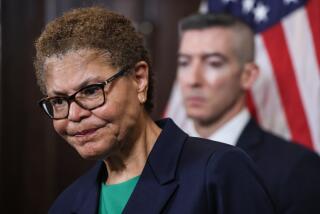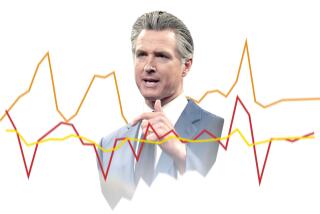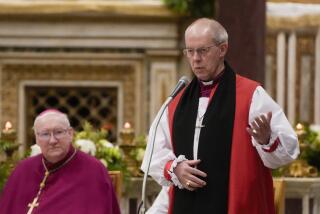Vatican Holy See Continues to Run in Red : Peter’s Pence to Be Used to Offset Projected $61.8-Million Deficit for ’88
- Share via
VATICAN CITY — Spending twice its income, the complex, 2,357-member Vatican bureaucracy called the Holy See will again have losses of more than $1 million a week this year. This is the estimate of an international panel of cardinals seeking long-term solutions to what has become a chronic financial crisis.
A projected deficit for 1988 of $61.8 million will be offset, as past deficits have been offset, by contributions intended in part for the poor from Roman Catholics around the world.
The faithful are proving to have deep pockets, but even their sharply increased generosity has failed to sop up the red ink spilled by a complex and ingrained bureaucracy that includes radio announcements in 34 languages, devil’s advocates and clerical diplomats at 116 Vatican legations around the world.
Pope John Paul II, who is spearheading modernization of the 500-year-old Curia that runs the church, is described as concerned but not dismayed by the financial troubles.
“The Pope thinks the Vatican should live from alms, not financial speculation,” said Joaquin Navarro, his spokesman.
That such matters are even being discussed publicly at the Vatican is a sign of changing times. In May of 1979, seven months after his election, he authorized the publication of Holy See budget totals for the first time, Navarro said.
Last October, the Vatican announced a $56.7-million deficit in its 1986 budget, and in January, Navarro said, a line-item accounting of the 1986 balance sheet was mailed, in five languages, to the church’s 3,000 bishops--another first.
“The bishops were told to make the figures public if they wished,” Navarro said. “If there is a need to raise money, the need can be best backed up with figures.”
The line-item figures were first made public by the National Conference of Bishops in the United States, where retired Cardinal John Krol of Philadelphia has been a leader in the call for financial reform.
The line items for 1986 show expenses of $113.9 million, about half of that for personnel, and income of $57.2 million, of which about half was from investments. Vatican Radio cost $10.3 million, including $6.4 million for new equipment, but generated only $1.2 million.
As Vatican deficits have mushroomed in the 1980s, principally because of increased personnel costs, they have been covered by accumulations from a yearly collection among the world’s 850 million Catholics. The collection, called Peter’s Pence, has been earmarked for church missions and charities and Holy See Expenses.
In 1986, the entire St. Peter’s Pence collection of $32 million--about a third of it from the United States--was applied to the deficit, together, according to budget explanatory notes, with $24.6 million “from the non-utilized reserves of Peter’s Pence of the preceding years, which reserves are by now nearly exhausted.”
Receipts from the collection increased sharply last year, to $50.3 million, nearly three times the 1983 level, but the shortfall is growing as well. The 1987 totals will not be made public until October, but the projection for the 1988 budget made by the cardinals’ commission last week was for expenses of $121.9 million and income of $60.1 million, leaving a fresh deficit of $61.8 million.
By the time the 15 cardinals of the commission, whose members include Krol and John J. O’Connor of New York as the American representatives, meet again this fall, an international auditing firm is expected to have been appointed to examine and overhaul 500 years of Vatican accounting practices.
No long-term financing program is yet in place, but the American cardinals favor creation of some type of international foundation created by contributions from wealthy Catholics. It would send its yearly income to the Vatican.
The Holy See’s financial dilemma is ironic. John Paul is surrounded by one of the world’s great collections of art treasures: 18,000 pieces worth billions of dollars. The Vatican calls the collection the church’s legacy to humanity and refuses to consider selling a single piece. On Vatican account books, the treasures are valued collectively as worth the equivalent of 1 cent.
Their exhibition, of course, generates considerable income. Nearly 2 million tourists visit Vatican museums every year, and the entrance fee one morning this week was the equivalent of $6.50.
Income from the museums and other Vatican ventures such as the sale of stamps and coins does not go to the Holy See but to the 108-acre Vatican city-state, the physical entity surrounded by the city of Rome.
The city-state, which provides municipal services to the Vatican and employs a security force of 200 Swiss Guards, is in the black. Its 1988 budget projection, made public by the cardinals last week, is for income of $84.3 million and expenses of $75.4 million.
The financial well-being of the city state, like that of some wealthy religious orders and well-to-do dioceses around the world, is scant solace to the Pope. Where the money is to come from is a nagging problem as he puts the final touches on promised administrative reform of the Vatican’s three dozen congregations, secretariats, councils and commissions. They are charged with such varied tasks as protecting the faith, maintaining foreign missions, relating to other world religions, advancing Catholic education and examining the causes of saints and the causes for the annulment of marriages.
More to Read
Sign up for Essential California
The most important California stories and recommendations in your inbox every morning.
You may occasionally receive promotional content from the Los Angeles Times.










